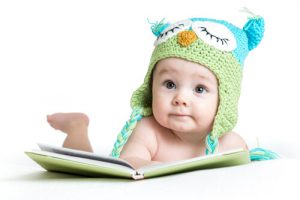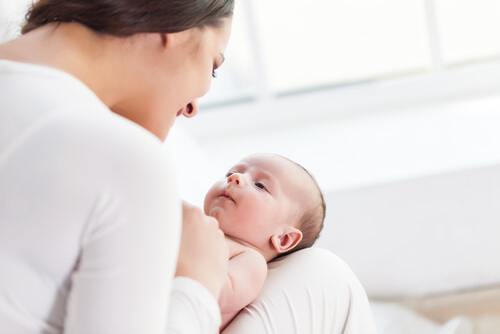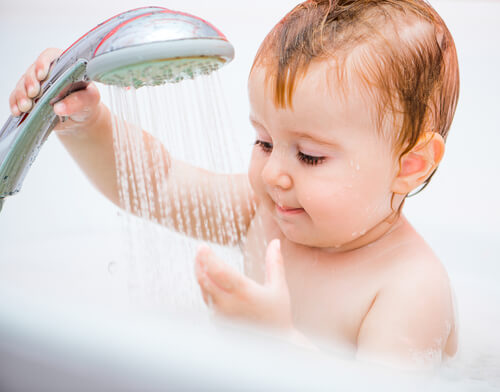Stimulation For Babies To Develop Their Senses: 0-6 Months

Stimulation for babies plays an important role in developing their senses during the first stage of their life, from birth to six months.
At this age, babies begin to identify sensations in their body and make demands to satisfy their basic needs, such as nourishment or sleep. At this stage, they need the help of a person to guide them.
This is something many parents find difficult, so here are some tips and ideas to begin stimulating your baby and activating their senses.
Stimulation for babies from birth to 6 months
0 to 3 months
At this stage, it’s important to simulate the following areas of your child’s brain:
- Tactile area: to stimulate your baby’s sense of touch, you can bathe your baby using items with different textures, such as sponges, gloves and so on. They will learn to identify the different sensations. You can also give them a gentle massage after their bath, focusing first on one side and then the other.
- Vestibular area: this relates to movement. To stimulate this area of their brain, rock them very gently from side to side and up and down. Give them toys with different weights, and expose them to different kinds of sounds.
- Motor area: help them move their limbs. Pick your baby up so they can see their surroundings, and play bicycle with their legs.
- Senses: show them picture books with brightly colored images and objects, which they can follow with their eyes.

4 to 6 months
At this stage you can stimulate the following areas:
- Tactile area: hug your baby gently, then a little harder. This way they’ll be able to experience different sensations in their muscles.
- Senses: it’s important to read to them and sing them songs.
Activating babies’ senses up to 6 months of age
Stimulation of the senses can come from different areas of the human body, and need to be varied to be effective.
We can talk about various types of stimulation for babies which help to develop their senses.
This is known as sensory stimulation, and it goes hand in hand with certain activities that we’ll describe below.
Auditory stimulation:
To stimulate your baby’s sense of hearing, we recommend:
- Using toys that make various sounds
- Imitating the sounds your baby makes
- Speaking aloud when you’re around your baby
- Distorting your voice
- Playing music for your child
- Speaking to your child
Visual stimulation
These activities provide stimulation for babies’ sense of sight.
- Using bright colors in their room
- Playing in front of a mirror
- Playing with toys that light up
- Hiding toys from your baby’s view for them to find
- Watching television
Tactile stimulation
These activities can help to stimulate your baby’s sense of touch.
- Teach your baby to play with clay, plasticine, dough, mud, etc.
- Bring them into contact with objects of different textures
- Point out objects of different sizes and shapes and encourage your baby to play with them.
Olfactory stimulation
Here are some things you can do to stimulate your baby’s sense of smell.
- Smell perfumes or other fragrances
- Before eating, bring food close to your child’s nose so they can smell different fruits and foods
- Make use of scented candles
- Teach them to identify everyday smells
Stimulating your baby’s sense of taste
Here’s the best way to stimulate your baby’s sense of taste:
- Expose your child to different flavors: bland, sour, salty, sweet, bitter

While you do these activities, tell your child what you are doing. This helps babies to become familiar with sounds and recognize aspects of their surroundings.
Stimulation for babies is an important way of complementing their development and helping them to grow up healthy.
You’ll need a lot of patience and enthusiasm, but the rewards are worth it. So, play with your little ones and help them to develop all their senses.
All cited sources were thoroughly reviewed by our team to ensure their quality, reliability, currency, and validity. The bibliography of this article was considered reliable and of academic or scientific accuracy.
- Al-Qarut Carreño, K. (2022). Desarrollo normal y anormal de las funciones visuales en niños (Bachelor’s thesis, Universitat Politècnica de Catalunya). Disponible en: https://upcommons.upc.edu/handle/2117/365822
- Español, S. (2010). Performances en la infancia: cuando el habla parece música, danza y poesía. Epistemus. Revista de Estudios en Música, Cognición y Cultura, 1(1), 57-95. Disponible en: https://revistas.unlp.edu.ar/Epistemus/article/view/2702
- Ferronato, P. A., Domellöf, E., & Rönnqvist, L. (2014). Early influence of auditory stimuli on upper-limb movements in young human infants: an overview. Frontiers in psychology, 5, 1043. Disponible en: https://www.ncbi.nlm.nih.gov/pmc/articles/PMC4166959/
- Mammen, M. A., Moore, G. A., Scaramella, L. V., Reiss, D., Shaw, D. S., Leve, L. D., & Neiderhiser, J. M. (2016). Infant patterns of reactivity to tactile stimulation during parent-child interaction. Infant behavior & development, 44, 121–132. Disponible en: https://www.ncbi.nlm.nih.gov/pmc/articles/PMC5125942/
- Nava, E., Grassi, M., Brenna, V., Croci, E., & Turati, C. (2017). Multisensory Motion Perception in 3-4 Month-Old Infants. Frontiers in psychology, 8, 1994. Disponible en: https://www.ncbi.nlm.nih.gov/pmc/articles/PMC5694769/
- Pedrosa, C., Caçola, P., & Carvalhal, M. I. (2015). Fatores preditores do perfil sensorial de lactentes dos 4 aos 18 meses de idade [Factors predicting sensory profile of 4 to 18 month old infants]. Revista paulista de pediatria : orgao oficial da Sociedade de Pediatria de Sao Paulo, 33(2), 160–166. Disponible en: https://www.ncbi.nlm.nih.gov/pmc/articles/PMC4516369/
- Tello Urgilés, E. (2008). Programa de estimulación táctil para niños de cero a seis meses (Bachelor’s thesis, Univesidad del Azuay). Disponible en: https://dspace.uazuay.edu.ec/handle/datos/7642
This text is provided for informational purposes only and does not replace consultation with a professional. If in doubt, consult your specialist.
